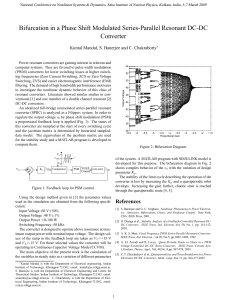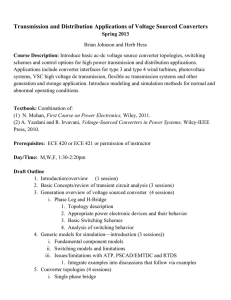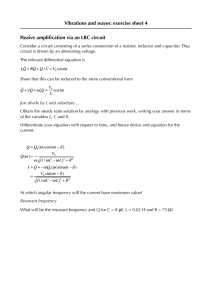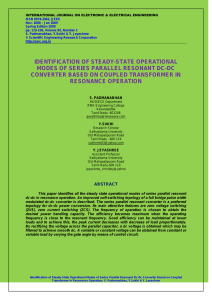Resonant LCC Converter for Low-Profile Applications
advertisement
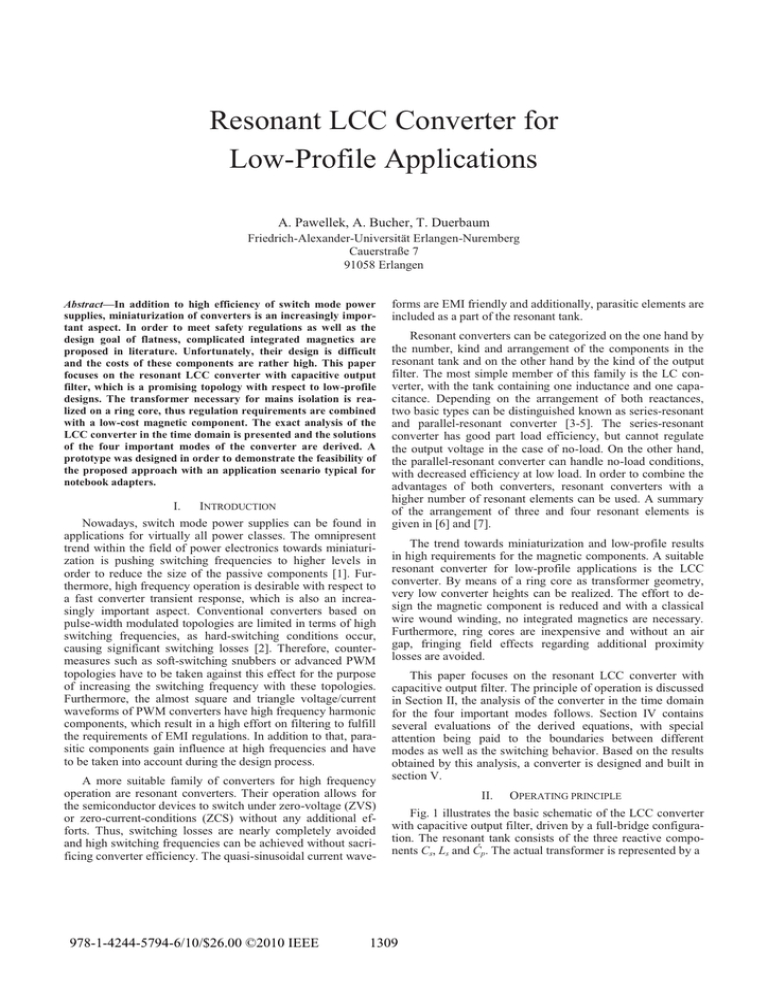
Resonant LCC Converter for Low-Profile Applications A. Pawellek, A. Bucher, T. Duerbaum Friedrich-Alexander-Universität Erlangen-Nuremberg Cauerstraße 7 91058 Erlangen Abstract—In addition to high efficiency of switch mode power supplies, miniaturization of converters is an increasingly important aspect. In order to meet safety regulations as well as the design goal of flatness, complicated integrated magnetics are proposed in literature. Unfortunately, their design is difficult and the costs of these components are rather high. This paper focuses on the resonant LCC converter with capacitive output filter, which is a promising topology with respect to low-profile designs. The transformer necessary for mains isolation is realized on a ring core, thus regulation requirements are combined with a low-cost magnetic component. The exact analysis of the LCC converter in the time domain is presented and the solutions of the four important modes of the converter are derived. A prototype was designed in order to demonstrate the feasibility of the proposed approach with an application scenario typical for notebook adapters. I. INTRODUCTION Nowadays, switch mode power supplies can be found in applications for virtually all power classes. The omnipresent trend within the field of power electronics towards miniaturization is pushing switching frequencies to higher levels in order to reduce the size of the passive components [1]. Furthermore, high frequency operation is desirable with respect to a fast converter transient response, which is also an increasingly important aspect. Conventional converters based on pulse-width modulated topologies are limited in terms of high switching frequencies, as hard-switching conditions occur, causing significant switching losses [2]. Therefore, countermeasures such as soft-switching snubbers or advanced PWM topologies have to be taken against this effect for the purpose of increasing the switching frequency with these topologies. Furthermore, the almost square and triangle voltage/current waveforms of PWM converters have high frequency harmonic components, which result in a high effort on filtering to fulfill the requirements of EMI regulations. In addition to that, parasitic components gain influence at high frequencies and have to be taken into account during the design process. A more suitable family of converters for high frequency operation are resonant converters. Their operation allows for the semiconductor devices to switch under zero-voltage (ZVS) or zero-current-conditions (ZCS) without any additional efforts. Thus, switching losses are nearly completely avoided and high switching frequencies can be achieved without sacrificing converter efficiency. The quasi-sinusoidal current wave- 978-1-4244-5794-6/10/$26.00 ©2010 IEEE forms are EMI friendly and additionally, parasitic elements are included as a part of the resonant tank. Resonant converters can be categorized on the one hand by the number, kind and arrangement of the components in the resonant tank and on the other hand by the kind of the output filter. The most simple member of this family is the LC converter, with the tank containing one inductance and one capacitance. Depending on the arrangement of both reactances, two basic types can be distinguished known as series-resonant and parallel-resonant converter [3-5]. The series-resonant converter has good part load efficiency, but cannot regulate the output voltage in the case of no-load. On the other hand, the parallel-resonant converter can handle no-load conditions, with decreased efficiency at low load. In order to combine the advantages of both converters, resonant converters with a higher number of resonant elements can be used. A summary of the arrangement of three and four resonant elements is given in [6] and [7]. The trend towards miniaturization and low-profile results in high requirements for the magnetic components. A suitable resonant converter for low-profile applications is the LCC converter. By means of a ring core as transformer geometry, very low converter heights can be realized. The effort to design the magnetic component is reduced and with a classical wire wound winding, no integrated magnetics are necessary. Furthermore, ring cores are inexpensive and without an air gap, fringing field effects regarding additional proximity losses are avoided. This paper focuses on the resonant LCC converter with capacitive output filter. The principle of operation is discussed in Section II, the analysis of the converter in the time domain for the four important modes follows. Section IV contains several evaluations of the derived equations, with special attention being paid to the boundaries between different modes as well as the switching behavior. Based on the results obtained by this analysis, a converter is designed and built in section V. II. OPERATING PRINCIPLE Fig. 1 illustrates the basic schematic of the LCC converter with capacitive output filter, driven by a full-bridge configuration. The resonant tank consists of the three reactive components Cs, Ls and Ćp. The actual transformer is represented by a 1309 Io T1 D1 D4 Ls Cs uS(t) Ui T4 uCs(t) iLs(t) iB(t) n T2 Ćp uĆp T3 Co RL Uo D2 D3 Figure 1. LCC converter with capacitive output filter cantilever equivalent circuit, whereas the magnetizing inductance is assumed to be large enough to be neglected. The parallel capacitance is connected to the secondary of the transformer. As a result, the parasitic capacitances of the bridge rectifier and the leakage inductance of the transformer are a part of the resonant tank. With a proper design of the magnetic component, Ls can be integrated within the transformer without the need for an additional series inductor. Thus, the parasitic stray inductance, which often causes problems in hard-switched PWM topologies, is incorporated into the operation of the converter. The full-bridge acts as inverter stage for the dc input voltage, generating a squarewave voltage with a duty cycle of 50 % which is applied to the input of the resonant tank. The diode-bridge rectifies the tank’s output current iB(t). The remaining harmonic frequencies are filtered out by the output capacitance Co. Its value is assumed to be large enough in order to neglect the remaining voltage ripple of Uo. one switching cycle, caused by the input bridge and the output rectifiers. The transitions of the input bridge are controlled by a control-IC, whereas the transitions of the bridge rectifier are dependent on the states of the converter. Therefore, a resonant converter is a nonlinear, time variant system. Nevertheless, the intervals between the transitions can be represented by a linear network. The state variables are the inductor current and the voltages across the capacitances which have to be periodic under steady-state conditions. In addition, the analysis can be reduced to one half of the switching period as the waveforms of resonant converters are antisymmetric. For this paper analytical steady-state solutions are derived, thus it is necessary to determine the occurring modes of the converter in advance. For a wide frequency range, the LCC converter with capacitive output has 4 modes of operation which are of interest. Each of these modes numbered 1 to 4 consists of a sequence of three subintervals, each with a different cycle of resonant and clamped intervals. For the analysis, the secondary side parallel capacitance Ćp is referred to the transformer primary side, resulting in the equivalent capacitance Cp = Ćp/n2 with the transformer turns ratio n. The equivalent circuits of the converter during the different subintervals are shown in Fig. 2 and Fig. 3. In order to perform the analysis of the complete switching cycle, the waveforms of the state variables for the three subintervals are required. During interval A, the inductance Ls and the two capacitances Cs and Cp are resonating with the upfront unknown starting values iLs t 0 iLs 0 The occurring subintervals can be divided into two major categories. With the rectifier conducting, the voltage across the parallel capacitance is clamped to the output voltage with uĆp(t) = ±Uo and energy is transferred to the output. The transition of the diode bridge is determined by the zero-crossing of the inductor current iL(t) setting off a resonance with all four diodes reverse biased. During this resonant subinterval, the complete inductor current charges the parallel capacitance Ćp until uĆp(t) reaches the output voltage ±Uo. Due to this discontinuous energy transfer, the bulk output capacitor is stressed with high rms-currents. However, this is a typical characteristic for resonant converters with capacitive output filter. Although three resonant elements are present within the tank of the LCC converter, the behavior of the converter during subintervals with the tank resonating can be described by a second order differential equation. During subintervals with clamped parallel voltage, the parallel capacitance is not involved in the resonance. Hence, two different resonant frequencies can be identified, with this converter topology often referred to as multiresonant converter in literature. III. ANALYSIS uCs t uCp t 0 uCs 0 Ls Cs (1) iLs(t) Cp uCs(t) Ui 0 uCp 0 . uCp(t) Figure 2. Equivalent curcuit, interval A Ls Cs Cp Ui ±nUo Figure 3. Equivalent curcuit, interval B (+nUo) and C (-nUo) The resulting waveforms can be obtained by solving the differential equation e.g. by using the Laplace transformation. For a better overview and an easier calculation, the following base quantities for normalization and abbreviation are introduced: Several methods exist for the purpose of analysing resonant converters [8,9]. An approximation in the frequency domain is the First-Harmonic-Approximation (FHA) [9-11] and the Extended-First-Harmonic-Approximation (eFHA) [12-14]. An exact mathematical description is the analysis in the time domain [15]. The steady-state operation of resonant converters is characterized by several switching events during 1310 U norm I norm t norm Ui Rnorm U norm Rnorm 1 Z0 Ls Cs Z0 F Z0 2S f 0 Z Z0 1 Ls Cs (2) Ls Cs (3) f f0 (4) Q n 2 RL Z 0 M U0 Ui * ] Cs C p 1 Cs C p (5) 1 * (6) Based on this normalization, the normalized solution for interval A is given by 1 M jCs t n mCs t n Cs 0 1 * sin]t n J Ls 0 cos ]t n 1 M Cs 0 M Cp 0 1 M Cs 0 1 *>1 cos]t @ n 1 * sin]t n M Cs 0 J Ls 0 mCp t n M Cp 0 M Cp 0 * 1 * >1 cos ]t n @ J Ls 0 * 1 * sin]t n M Cp 0 . A (9) (Q = 3; Γ = 1; n = 1; F = 2) Figure 4. Waveforms mode 1 (10) 1 M Cs 0 # nM >1 cos tn @ J Ls 0 sint n M Cs 0 (11) mCp t n rnM . (12) A. Mode 1 Fig. 4 shows the waveforms of a complete switching cycle of the state variables for mode 1. In order to obtain a steady state solution for mode 1, a periodic solution for (7)-(12) representing the three subintervals in the time domain has to be found. Based on the waveforms’ symmetry, the values of the state variables at the end of the third interval are equal with opposite sign to those at the beginning of the switching cycle. Thus, a second order system of transcendental equations is derived with the unknown durations tn1 and tn2. 0 1 cos T1 ^>1 K @ cos T 2 >1 K @` > 0.5 >1 1 @ 1 * @cos T T 0.5 1 1 1 * cos T1 T 2 T 3 1 2 T3 (13) @ > @ 1 1 * sinT1 T 2 (14) with T1 Table I contains the interval sequence of the four modes for the first half of the switching period. At the beginning of each mode, the input bridge switches to the positive supply voltage Ui. After interval B and C, interval A must follow to charge the parallel capacitance Cp. For the analysis, relative time variables tn1 to tn3 are introduced, each starting at zero with the corresponding interval change. As a result, the normalized time variables tn1 and tn2 represent the durations of the first and the second interval. The duration of the third interval is the normalized half period less tn1 and tn2. > 2 sinT 3 1 1 * sinT1 T 2 0 ] t n1 , T2 tn2 , T3 ] S F tn1 tn 2 (15) and the abbreviation The upper sign in (10)-(12) is valid for subinterval B, the lower sign for subinterval C. 1 1 * sinT 2 ^>1 K @sinT 3 >1 K @sinT1 ` A (8) 1 M Cs0 # nM sintn J Ls 0 costn mCs t n C (7) Following the same steps for subinterval B and subinterval C (Fig. 3) one obtains jLs t n TABLE I. INTERVAL SEQUENCE mode 2 mode 3 mode 4 interval duration C A B tn1 A B A tn2 B A C π/F - tn1 - tn2 mode 1 A C A K 2FQ1 * S *. (16) For a given switching frequency and a given converter configuration, these durations can be determined by numeric means. The resulting output voltage for this operation point can be derived by taking the output current iB(tn) into account with M Q n 2 j B t n tn 2 FQ Sn ³ 0 j Ls t n dt n . (17) With known values for θ1 to θ2 the voltage transfer ratio M = Uo/Ui is given by M * >nX 1 * @ ^1 cos T1 >1 cos T 2 @ cos T 2 cos T1 T 3 1 1 * sinT 2 (18) >sinT1 sinT 3 sinT1 T 3 @` with X 1 1 * sinT 2 sinT 3 T1 cos T 2 cos T 3 T1 1 . (19) B. Mode 2 Fig. 5 illustrates the waveforms of the state variables with the interval sequence according to Table I over a switching period for mode 2. Following the same argumentation as in mode 1, two equations for the unknown interval durations are obtained. The first equation 1311 cos T1 >1 cos T 2 cos S F T 2 ] 1 1 * sinT 2 sinS F T 2 ] @ 1 ^>1 1 K @ >1 1 K @cos T 2 ` (20) delivers θ1 as a function of θ2 with T1 T2 t n1 , ]t n 2 , T3 S F tn1 tn 2 . ZCS ZVS (21) Substitution of (20) in 0 1 1 * sinT 2 cos T 3 cos T 2 sinT 3 sinT1 , (22) yields a single transcendental equation for θ2. With a valid solution for θ2, the dependent variable θ1 can be calculated with (20). The voltage transfer ratio M for mode 2 is then given by M X * cosT1 >cosT1 1@ >nX 1 *@ (23) 1 1 * sinT 2 sinT 3 T1 (24) cos T 2 cos T 3 T1 1 . C. Mode 3 and Mode 4 On the first look, the interval sequence for all four modes appears to be different. Nevertheless, the modes can be divided into two groups with a characteristic sequence of subintervals, with interval A as the resonant interval and interval B and C as the clamp interval: Mode 1& Mode 3 Mode 2 & Mode 4 resonance Ö clamp Ö resonance clamp Ö resonance Öclamp Thus, the steady state of mode 3 and mode 4 can also be described by means of the derived equations of mode 1 and mode 2 respectively. With the output diode bridge conducting in the opposite direction, a negative sign for the voltage transfer ratio M in (18) and (23) is obtained due to the reverse flow direction of iB(t). IV. EVALUATION Fig. 6 shows the voltage transfer ratio M given by (18) and (23). A turns ratio of n = 8 and a capacitor ratio of Γ = 10 is assumed. Additionally, the area with ZVS and ZCS is highlighted. In order to provide the specified output voltage under full load conditions with Q = Qmin at the minimum input C A B (Q = 2; Γ = 1; n = 1; F = 1.35) Figure 5. Waveforms Mode 2 Figure 6. Voltage ratio M = Uo/Ui versus normalized switching frequency F for n = 8, Γ = 10 voltage (M = Mmax), a suitable value for the turns ratio n and parameter Γ must be chosen. Attention must be paid to the peak value of the Qmin curve which must be higher than the specified maximum voltage conversion ratio in order to fulfill the specification. Fig. 7 illustrates the switching behavior as a function of the normalized switching frequency F and the normalized load resistor Q. Additionally, the area of operation of an exemplary converter design with 0.095 < M < 0.152 corresponding to the input voltage range and a minimum load resistor of Qmin = 2 at full load is highlighted. According to the figure, the converter is operating under ZVS conditions for the complete load range. A negative series inductor current is necessary at the beginning of the switching cycle when the input bridge switches to the positive supply voltage. The current flowing in the negative direction charges the parasitic capacitances of the MOSFETs, allowing them to switch under zero-voltage conditions. The boundary between ZVS and ZCS is reached if the inductor current crosses zero exactly at the beginning of the switching cycle. Therefore, a condition exists to calculate the switching behavior as a function of the load and the switching frequency (Fig. 7). The appearing mode depends on the load resistor and the switching frequency. Starting with the converter in mode 1 and reducing the load resistor, the clamped interval C is increased at the expense of the first interval in order to transfer more power to the output. Therefore, the duration tn1 is reduced until it vanishes at the boundary between mode 1 and mode 2. The same considerations apply to the boundary of mode 3 and mode 4. It can be shown, that mode 1 occurs only for frequencies F > ζ and mode 4 only for frequencies F < 1. Thus, the boundary of mode 3 and mode 2 is suited in the frequency range 1 < F < ζ, where the third interval vanishes. The mode boundaries are shown in Fig. 8. The operation area in this picture is the same as in Fig. 7. For no-load conditions with Q → ∞ mode 2 vanishes, with the boundaries of mode 1 and mode 3 approaching one another. The vertical asymptotic is situated at the normalized switching frequency F = ζ with ζ = 3.3 for the discussed example. Together with the ZVS boundary of Fig. 7 it can be stated that ZVS is obtained for F > ζ under all load conditions. In order to obtain a regulated output voltage, the switching frequency has to be controlled for different load situations. Therefore the operating area has to be limited to mode 2 and mode 1 if ZVS is to be guaranteed. Table II summarizes the switching behavior of the four 1312 Figure 9. Winding structure For the transformer, a ring core TN32/19/13 [16] is used. To meet the requirements of the 10 mm height constraint, the height of the core is reduced down to 7 mm. Fig. 9 shows the arrangement of the primary side and the secondary side on the core. A rather large distance between primary and secondary is on the one hand necessary in order to fulfill safety requirements, on the other hand high values for Ls can be expected. Figure 7. Switching behavior as function of normalized load resistor Q and normalized switching frequency F TABLE II. SWITCHING BEHAVIOUR OF THE FOUR MODES mode 1 mode 2 mode 3 mode 4 ZVS ZVS ZVS, ZCS ZCS The transformer data is listed in Table IV. The values of the leakage inductance Ls, the magnetizing inductance Lh and the transformer turns ratio n are based on the cantilever-model of a two winding transformer. An additional degree of freedom for optimization is the capacitance ratio Γ. A capacitor ratio of Γ = 11 is used as an optimal value. With denormalization, the values of the capacitors are Figure 8. Mode boundaries modes. Additional modes exists with frequencies F < ζ/(1+ ζ), which are characterized by more than three subintervals. V. DESIGN An application scenario typical for notebook adapters was chosen with an input voltage range of 250 V - 400 V and an output voltage of 19 V. The dc-bus voltage is generated by a preregulated ac-dc stage with power factor correction and minimized conducted emissions, in order to fulfill the requirements of EMI regulations. The LCC converter provides a maximum continuous output power of 100 W. An important design-goal was a height constraint of 10 mm. Based on the results obtained by the methods of chapter III, a converter with the specifications according to Table III was designed and built. Cs = 13.6 nF = 6.8 nF + 6.8 nF (25) Cp = 66 nF = 33 nF + 33 nF. (26) In each case, two capacitors are parallelled, in order not to exceed the maximal current through the capacitors. Fig. 10 shows the prototype of the designed LCC converter. Normal litz wire is used for the transformer windings to eliminate hf losses. To meet safety regulations, triple isolated wire would be necessary. This modification only has a small effect on the transformer data and thus, no significant influence on the design process can be expected. The denormalized voltage transfer function is shown below in Fig. 11. Additionally, the area of operation is highlighted. The maximum switching frequency of 500 kHz is reached in the case of no load with the maximum input voltage. The minimum frequency of 133 kHz is obtained at full load conditions together with the minimum input voltage of 250 V. A wide frequency span is necessary to control the output voltage through the whole load For the input a half-bridge configuration was chosen, reducing the amplitude of the driving square-wave voltage to one half of the nominal DC input voltage. A turns ratio of n = 7 is chosen as design goal for the transformer together with an inductance value of Ls above 150 µH in order to get less reactive currents. TABLE III. CONVERTER SPECIFICATION Ui,min = 250 V – 400 V input voltage range Uo= 19 V output voltage Po = 100 W output power fmax = 500 kHz maximum switching frequency hmax = 10 mm maximum converter height Core: Material: Primary side Secondary side Ls = 192 µH TABLE IV. TRANSFORMER DATA TN32/19/13, reduced to 7 mm 3F3 Np = 63 Ns = 9 35 x 0,1 mm 90 x 0,1 mm Lh = 5830 µH n=7 20 mm Figure 10. Prototype 1313 RP = 113.8 mΩ RS = 9.35 mΩ and the switching behavior as well as design parameters such as rms-values can be calculated. It has been shown that ZVS is tank is designed properly. In the last section of the paper, a prototype was designed based on a specification typical for notebook adapters. A ring core was chosen for the magnetic component with a classical wire wound structure, thus expensive integrated magnetic components are avoided. The prototype reaches a converter height of 10 mm, but also flatter designs are possible. VII. REFERENCES [1] Figure 11. Voltage transfer function and input voltage range. In spite of the full bridge rectification, the converter reaches an efficiency up to 92 % at the optimum operating point. The corresponding waveforms for the state variables at the operating point given in Table V are shown in Fig. 12. VI. [2] [3] CONCLUSION One of the main trends driving the development of power electronics is miniaturization. The family of resonant converters are attractive for high switching frequency operation as the size of the passive components can be reduced without sacrificing converter efficiency. Offering virtually lossless switching without any additional effort and including parasitic components into the design, they are promising candidates compared to traditional hard-switching PWM converters. This paper presented the three-element multiresonant LCC converter with capacitive output filter, which is suitable for lowprofile applications. The converter was analysed in the time domain and four modes of operation were identified which occur for a wide frequency range. The steady waveforms of converter can be calculated by solving a second order transcendental equation system (mode 1 and mode 3) or by solving a single nonlinear equation (mode 2 and mode 4). Based on the voltage conversion ratio, the mode boundaries guaranteed throughout the complete load range if the resonant TABLE V. OPERATING POINT Ui = 300 V input voltage: Po = 83 W output load: f = 190 kHz switching frequency: [4] [5] [6] [7] [8] [9] [10] [11] [12] [13] [14] [15] [16] Figure 12. Waveforms at the operating point 1314 H. de Groot, E. Janssen, R. Pagano, and K. Schetters, “Design of a 1-MHz LLC Resonant Converter Based on a DSP-Driven SOI HalfBridge Power MOS Module,” IEEE Transactions on Power Electronics 22, vol. 6, 2007, pp. 2307-2320. D. Kübrich, T. Dürbaum, and A. Bucher, “Investigation of Turn-Off Behaviour under the Assumption of Linear Capacitances,” PCIM Conference, May/June 2006, Nuremberg, Germany. A. Bucher, T. Dürbaum, and D. Kübrich, “Comparison of First Harmonic Approximation with exact Solution in case of a Series Resonant Converter,” PCIM Conference, May/June 2006, Nuremberg, Germany. A. Bucher, T. Dürbaum, and D. Kübrich, “Comparison of Methods for the Analysis of the Parallel Resonant Converter with Capacitive Output Filter,” 12th European Conference on Power Electronics and Applications EPE, September 2007, Aalborg, Denmark. A. Bucher, T. Dürbaum, D. Kübrich, and A. Stadler, “Comparison of Different Design Methods for the Parallel Resonant Converter,” 12th International Power Electronics and Motion Control Conference EPE-PEMC, September 2006, Portoroz, Slovenia. R. P. Severns, “Topologies for Three-Element Resonant Converters,” IEEE Transactions on Power Electronics 7, vol. 1, 1992, pp. 89-98. I. Batarseh, “Resonant Converter Topologies with Three and Four Energy Storage Elements,” IEEE Transactions on Power Electronics 9, vol. 1, 1994, pp. 64-73. M. P. Foster, H. I. Sewell, D. A. Stone, and C. M. Bingham, “Review of modeling methodologies to facilitate rapid simulation of high order resonant converters,” 8th European Conference on Power Electronics and Applications EPE 2001, Gratz – Austria. A. Bucher, T. Duerbaum, D. Kuebrich, and S. Hoehne, “Multiresonant LCC converter - comparison of different methods for the steady-state analysis,” Power Electronics Specialists Conference, 2008, pp. 1891-1897. R. L. Steigerwald, “A Comparison of Half-Bridge Resonant Converter Topologies,” IEEE Transactions on Power Electronics 3, vol. 2, 1988, pp. 174-182. M. C. Tsai, “Analysis and implementation of a full-bridge constantfrequency LCC-type parallel resonant converter,” IEE Proceedings on Electric Power Applications 141, vol. 3, 1994, pp. 121-128. A. J. Forsyth, G. A. Ward, and S. V. Mollov, “Extended fundamental frequency analysis of the LCC resonant converter,” IEEE Transactions on Power Electronics 18, vol. 6, 2003, pp. 1286-1292. A. K. S. Bhat, and S. B. Dewan, “A generalized approach for the steady-state analysis of resonant inverters,” IEEE Transactions on Industry Applications 25, vol. 2, 1989, pp. 326-338. G. Ivensky, A. Kats, and S. Ben-Yaakov, “An RC Load Model of parallel and Series-Parallel Resonant DC-DC Converters with Capacitive Output Filter,” IEEE Transactions on Power Electronics 14, vol. 3, 1999, pp. 515-521. S. D. Johnson, and R. W Erickson, “Steady-state analysis and design of the parallel resonant converter,” IEEE Transactions on Power Electronics 3, vol. 1, 1988, pp. 93-104. Ferroxcube datasheet TN32/19/13. URL: www. ferroxcube. com/prod/assets/tn321913.pdf.

